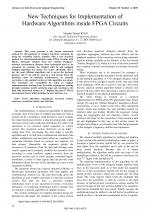| 2/2010 - 3 |
New Techniques for Implementation of Hardware Algorithms inside FPGA CircuitsIOAN, A. D. |
| Extra paper information in |
| Click to see author's profile in |
| Download PDF |
Author keywords
algorithm organigram, execution section, sequencer, transition matrix, user interface
References keywords
fpga(7), design(7), link(5), xilinx(4)
Blue keywords are present in both the references section and the paper title.
About this article
Date of Publication: 2010-05-31
Volume 10, Issue 2, Year 2010, On page(s): 16 - 23
ISSN: 1582-7445, e-ISSN: 1844-7600
Digital Object Identifier: 10.4316/AECE.2010.02003
Web of Science Accession Number: 000280312600003
SCOPUS ID: 77954626692
Abstract
This work presents a less known theoretical method for the synthesis of complex hardware automata by using the transition matrix, together with a new practical method for visual implementation inside FPGA circuits, with library schematic symbols from the Altium Designer software environment. Because these techniques need to be presented by example, the classical shift and add unsigned multiply algorithm was chosen for review. Obviously, this is not the most efficient algorithm, but it serves the declared purpose and it can still be used in a real system when the hardware must be minimal. Furthermore, an essential correction to the optimal version of this algorithm was made. The techniques are exemplified by doing an original implementation: starting from the initial organigram, passing through transition matrix synthesis stage and reaching to the final fully functional system on a Digilent Spartan-3 FPGA development board, which includes the user interface too. |
| References | | | Cited By |
Web of Science® Times Cited: 3 [View]
View record in Web of Science® [View]
View Related Records® [View]
Updated today
SCOPUS® Times Cited: 4
View record in SCOPUS® [Free preview]
View citations in SCOPUS® [Free preview]
[1] Coarse Grained ADRES Based MIMO-OFDM Transceiver with New Radix- $${2}^{5}$$ 2 5 Pipeline FFT/IFFT Processor, Janakiraman, N., Nirmalkumar, P., Akram, Syed Mohsin, Circuits, Systems, and Signal Processing, ISSN 0278-081X, Issue 3, Volume 34, 2015.
Digital Object Identifier: 10.1007/s00034-014-9880-8 [CrossRef]
[2] FPGA Implementation of BLDC Motor Driver with Hall Sensor Feedback, Mihalache, George, Ioan, Aleodor-Daniel, 2018 International Conference and Exposition on Electrical And Power Engineering (EPE), ISBN 978-1-5386-5062-2, 2018.
Digital Object Identifier: 10.1109/ICEPE.2018.8559886 [CrossRef]
[3] Designing an optimal single chip FPGA video interface for embedded systems, Ioan, Aleodor Daniel, 2010 3rd International Symposium on Electrical and Electronics Engineering (ISEEE), ISBN 978-1-4244-8406-5, 2010.
Digital Object Identifier: 10.1109/ISEEE.2010.5628542 [CrossRef]
[4] FPGA implementation of a matrix structure for integer division, Alecsa, Bogdan Claudiu, Ioan, Aleodor Daniel, 2010 3rd International Symposium on Electrical and Electronics Engineering (ISEEE), ISBN 978-1-4244-8406-5, 2010.
Digital Object Identifier: 10.1109/ISEEE.2010.5628505 [CrossRef]
Disclaimer: All information displayed above was retrieved by using remote connections to respective databases. For the best user experience, we update all data by using background processes, and use caches in order to reduce the load on the servers we retrieve the information from. As we have no control on the availability of the database servers and sometimes the Internet connectivity may be affected, we do not guarantee the information is correct or complete. For the most accurate data, please always consult the database sites directly. Some external links require authentication or an institutional subscription.
Web of Science® is a registered trademark of Clarivate Analytics, Scopus® is a registered trademark of Elsevier B.V., other product names, company names, brand names, trademarks and logos are the property of their respective owners.
Faculty of Electrical Engineering and Computer Science
Stefan cel Mare University of Suceava, Romania
All rights reserved: Advances in Electrical and Computer Engineering is a registered trademark of the Stefan cel Mare University of Suceava. No part of this publication may be reproduced, stored in a retrieval system, photocopied, recorded or archived, without the written permission from the Editor. When authors submit their papers for publication, they agree that the copyright for their article be transferred to the Faculty of Electrical Engineering and Computer Science, Stefan cel Mare University of Suceava, Romania, if and only if the articles are accepted for publication. The copyright covers the exclusive rights to reproduce and distribute the article, including reprints and translations.
Permission for other use: The copyright owner's consent does not extend to copying for general distribution, for promotion, for creating new works, or for resale. Specific written permission must be obtained from the Editor for such copying. Direct linking to files hosted on this website is strictly prohibited.
Disclaimer: Whilst every effort is made by the publishers and editorial board to see that no inaccurate or misleading data, opinions or statements appear in this journal, they wish to make it clear that all information and opinions formulated in the articles, as well as linguistic accuracy, are the sole responsibility of the author.



